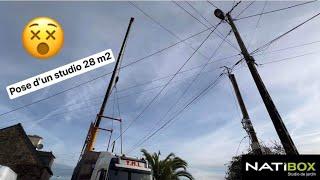When tiling, workers install a pulley - cableway system between a high - lying location and the new house. They take advantage of the labor - saving feature of pulleys and the assistance of the terrain elevation difference. Tiles are placed on the cableway's carrying device, and workers can steadily transport them to the roof by pulling a rope, which is both efficient and safe.
The smart methods employed by the workers and the improvement in operational efficiency are as follows:
- Leveraging the labor - saving property of pulleys: Workers apply the working principle of pulleys. The installed cableway system composed of pulleys may include a combination of fixed pulleys and movable pulleys. Fixed pulleys are used to change the direction of force, enabling workers to apply force more conveniently on the roof. Movable pulleys, on the other hand, can save effort, allowing workers to lift heavier tiles with less force and reducing the operational difficulty.
- Utilizing the potential - energy assistance from the terrain elevation difference: The starting point of the cableway is set at a location that is at a certain distance from the newly - built house and at a higher elevation. The terrain elevation difference gives the tiles a certain amount of potential energy at the initial stage. During the tile transportation, this potential energy can be converted into kinetic energy, assisting the tiles in moving towards the roof and reducing the force and energy consumption required for workers to pull the rope.
- Setting up a stable track with the cableway: Installing the cableway provides a stable track for tile transportation. Tiles placed on the cableway's carrying device can move smoothly along a fixed path, avoiding situations such as shaking, deviation, or falling during the transportation process. This enables workers to transport tiles more accurately to the desired location.
Improvement in operational efficiency:
Using the pulley - cableway system can save labor and time, enhance safety, and facilitate continuous operation. Therefore, this method indeed...
The smart methods employed by the workers and the improvement in operational efficiency are as follows:
- Leveraging the labor - saving property of pulleys: Workers apply the working principle of pulleys. The installed cableway system composed of pulleys may include a combination of fixed pulleys and movable pulleys. Fixed pulleys are used to change the direction of force, enabling workers to apply force more conveniently on the roof. Movable pulleys, on the other hand, can save effort, allowing workers to lift heavier tiles with less force and reducing the operational difficulty.
- Utilizing the potential - energy assistance from the terrain elevation difference: The starting point of the cableway is set at a location that is at a certain distance from the newly - built house and at a higher elevation. The terrain elevation difference gives the tiles a certain amount of potential energy at the initial stage. During the tile transportation, this potential energy can be converted into kinetic energy, assisting the tiles in moving towards the roof and reducing the force and energy consumption required for workers to pull the rope.
- Setting up a stable track with the cableway: Installing the cableway provides a stable track for tile transportation. Tiles placed on the cableway's carrying device can move smoothly along a fixed path, avoiding situations such as shaking, deviation, or falling during the transportation process. This enables workers to transport tiles more accurately to the desired location.
Improvement in operational efficiency:
Using the pulley - cableway system can save labor and time, enhance safety, and facilitate continuous operation. Therefore, this method indeed...
- Catégories
- Location Maison à louer


















Commentaires